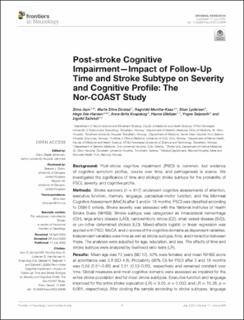| dc.description.abstract | Background: Post-stroke cognitive impairment (PSCI) is common, but evidence
of cognitive symptom profiles, course over time, and pathogenesis is scarce. We
investigated the significance of time and etiologic stroke subtype for the probability of
PSCI, severity, and cognitive profile.
Methods: Stroke survivors (n = 617) underwent cognitive assessments of attention,
executive function, memory, language, perceptual-motor function, and the Montreal
Cognitive Assessment (MoCA) after 3 and/or 18 months. PSCI was classified according
to DSM-5 criteria. Stroke severity was assessed with the National Institutes of Health
Stroke Scale (NIHSS). Stroke subtype was categorized as intracerebral hemorrhage
(ICH), large artery disease (LAD), cardioembolic stroke (CE), small vessel disease (SVD),
or un-/other determined strokes (UD). Mixed-effects logistic or linear regression was
applied with PSCI, MoCA, and z-scores of the cognitive domains as dependent variables.
Independent variables were time as well as stroke subtype, time, and interaction between
these. The analyses were adjusted for age, education, and sex. The effects of time and
stroke subtype were analyzed by likelihood ratio tests (LR).
Results: Mean age was 72 years (SD 12), 42% were females, and mean NIHSS score
at admittance was 3.8 (SD 4.8). Probability (95% CI) for PSCI after 3 and 18 months
was 0.59 (0.51–0.66) and 0.51 (0.52–0.60), respectively and remained constant over
time. Global measures and most cognitive domains were assessed as impaired for the
entire stroke population and for most stroke subtypes. Executive function and language
improved for the entire stroke population (LR) = 9.05, p = 0.003, and LR = 10.38, p =
0.001, respectively). After dividing the sample according to stroke subtypes, language
Aam et al. Post-stroke Cognitive Impairment
improved for ICH patients (LR = 18.02, p = 0.003). No significant differences were found
in the severity of impairment between stroke subtypes except for attention, which was
impaired for LAD and CE in contrast to no impairment for SVD (LR = 56.58, p < 0.001).
Conclusions: In this study including mainly minor strokes, PSCI is common for all
subtypes, both early and long-term after stroke, while executive function and language
improve over time. The findings might contribute to personalizing follow-up and offer
new insights into underlying mechanisms. Further research is needed on underlying
mechanisms, PSCI prevention and treatment, and relevance for rehabilitation. | en_US |
| dc.description.localcode | © 2020 Aam, Einstad, Munthe-Kaas, Lydersen, Ihle-Hansen, Knapskog, Ellekjær, Seljeseth and Saltvedt. This is an open-access article distributed under the terms of the Creative Commons Attribution License (CC BY). The use, distribution or reproduction in other forums is permitted, provided the original author(s) and the copyright owner(s) are credited and that the original publication in this journal is cited, in accordance with accepted academic practice. No use, distribution or reproduction is permitted which does not comply with these terms. | en_US |

